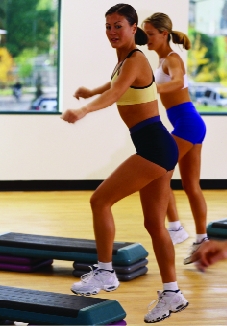Digital Mentoring
Create a video web page as an instructional resource for new step instructors.

Do you remember who taught you how to lead
a group fitness class? Did you have a mentor who showed you the ropes? Maybe you obsessively took notes at fitness conventions or taught yourself by watching videotapes. Regardless, at one point or another we were all beginners—now it’s our turn to teach the next generation.
Years ago we might have handed our favorite videotapes to an upcoming instructor, told her to look for specific choreography cues and breakdowns, and then followed
up with some type of informal quiz or practical review. Analog videotape is still a viable medium; however, digital technology has become a part of our everyday lives, changing the way we communicate. Take advantage of this as a learning platform to teach beginning step instructors how to lead group fitness classes safely.
Benefits of Bytes
An instructional digital video, accessed from a simple Web site, is an effective and comprehensive way to teach movement. It allows beginning instructors to view information in a clear, convenient format. It also breaks down language barriers—ideas are more easily understood, especially by visual learners. Of course, these advantages apply to videotapes as well. However, the Internet is more current and the information is disseminated widely and quickly. Digital technology eliminates the lag time involved in rewinding a tape to search for a particular segment. In essence, a digital video is a perfect teaching tool.
The number-one goal for our “Exercise Leadership” course at the United States Military Academy at West Point, New York, is “to develop the leadership skills and technical background necessary to conduct safe, effective and motivational group exercise classes.” From this starting point, we developed an instructional video that we added to our Web site.
As the former course director for our gymnastics program, I had developed
a similar video Web site that demonstrated the required movement skills. This was a very successful project because it allowed students to preview skills and practice on their own. However, bringing this idea to our step class was new territory.
We began our training by introducing critical risk management items, instructional cues and teaching techniques. Only after these concepts were clearly explained, demonstrated and practiced did we introduce the video section of the Web page. Once we had launched the site—evaluating each course of action as we progressed—we realized the following advantages:
- We didn’t have to print and update multiple copies of our instruction manual.
- Students accessed the video at their convenience, making it easier to practice.
- Novices were able to focus on basic units of movement.
- Peer-coaching partners modeled and evaluated correct performance.
Demonstration is important when presenting information; therefore, our Web site included actual demonstrations—precise images that conveyed correct performance, helping viewers to learn. In addition, the site highlighted essential learning and teaching prompts. Subtitles beneath the viewing screen displayed actual verbal cues; for example, “Down, Down, Up, Lift.”
Creating the Video
If you decide to build your own Web site, begin with a written framework from which you can later launch a video clip hyperlink. Check with your organization to see if it has some untapped technological resources you can use. In our case a main Web page already existed, so we housed our instructional page as a link.
Approach the project in small steps and use members of your teaching team. They will bring new ideas to the table. For example, our instructors gave us input on filming locations that were well-lit, clutter-free and quiet. Later, as we were filming, someone recommended that we perform the steps at a slightly slower speed. These suggestions made a positive impact on the final product.
When used in conjunction with a good software program, the following tips will help you organize and produce an instructional video Web page:
- List the Steps You Want to Describe for Your Audience. Anticipating rank beginners as well as marginally experienced students, we organized our list into two skill sets. The first group consisted of 15 basic steps a novice could learn and teach from the front, with progressions from the side, end, corner, etc. In the second group, all moves were approached from directions other than the front. We listed both groupings from simple to complex and categorized moves by directional approach.
- Keep Each Move or Combination Simple. Moves need to be as stand-alone as possible so they can be “taken apart” visually. Take advantage of digital technology to allow viewers to click quickly from one move to the next.
- Organize Your List From Easy to Slightly More Complex. Start simple. Organize steps into basic, intermediate and advanced moves and group steps according to directional approaches. This way, learners can master one step and progress to another when they
are ready. - Annotate Each Move According to the Directional Approaches That Are Possible. A single step may be performed from many different directions. Allow viewers to observe all options: front, side, end, corner, top and astride.
- Compose a Chart or Matrix, Noting Moves and Directional Approaches. This will eventually become the introductory site to your Web page. A concise listing allows viewers to grasp the big picture in one frame.
- Film Your Steps Using a Digital Video Camera. Do single clips demonstrating multiple repetitions of a basic eight-count move. Remember, the purpose of this project is to construct a study guide. If you display a basic move as a stand-alone demonstration, viewers can internalize the concept as a single unit. They can later add on to this base as experience allows.
- Demonstrate Steps Slower Than Actual Performance Speed. Beginners need a little more “mental time” to observe and process the steps. A good starting place is in the 116 to 118 beats per minute range.
- Choose a Soundtrack. Only use music you have permission to use in public. To ensure that we violated no copyright issues, we used an accompanist in the background who played
simple chord combinations at a predetermined speed. You might also play simple percussive instruments to a metronome. Of course, getting permission to use popular music adds variety to your Web page. - Add “Hot-Button” Links on Your Organizational Chart for Each Move and Direction. Many authoring software programs allow digital video clips to
be linked to a Web page. We chose QuickTime because it had the clearest picture quality, allowed for stop-action analysis and had the least amount of time delay in transporting the video to the screen. - Link Your Video Clips to the Hot Buttons. Viewers can click on the buttons of their choice to view the clips.
Guided Reflection
With your video complete and published on your Web page, your job as mentor has only just begun. It is critical that you, as a veteran instructor, act as the liaison between beginners and the video instruction. The interaction between teacher and students is still necessary. Guide your protégés through their visual experiences in creative and motivating ways. Determine if they are observing the important points of each skill. I call this “guided reflection.”
Ask each trainee for a written self-evaluation, perhaps via e-mail or during your in-service meetings. After the new instructors have observed a particular step, have them analyze a certain movement in terms of something they already know. For example, when introducing the knee-lift step, ask them to analyze the differences and similarities between the basic step, which they’ve previously learned, and the knee-lift step. Or, when introducing a new move, ask if they can determine if the skill employs a single or an alternating lead leg. And ask them to describe
their directional approaches, simply to encourage them to use basic observational skills.
In addition to using the video Web page as a teaching tool, you can use it to share more advanced moves with other instructors, creating a far-reaching network. It can also serve exercise participants. Our project originally began
as a teaching aid for new instructors; however, as we developed the concept, it became apparent that participants might also appreciate the opportunity to review the steps. This would enable them to work out on their own, or in small groups, in preparation for the next class. Use this angle as an opening to get new instructors involved with participants; it adds a leadership dimension to their “digital” training.
Incorporating digital technology
into your mentoring program enhances your resource potential and enables
you to reach people efficiently and effectively. Use the video Web concept in any level of group fitness instructor training to introduce new skills. Whether you have one or a half dozen “newbies” under your wing, this is an excellent way to teach the basics to the next generation.
The quality of the final product will depend heavily on production details. Consider the following points before you begin filming your video:
- Make sure the area where you are filming is well-lit, with a “clean” background that won’t distract the viewer.
- Dress your model in simple, neat, solid-colored clothing that allows for clear viewing of the moves.
- Experiment with different angles to make sure you get the most technically accurate shot. When in doubt, film all options. You can decide later which one works best.
- Have an assistant on hand who can help with details such as keeping the area clear, adjusting the lighting and double-checking the moves for accuracy.
- Keep it simple. We chose not to use verbal cuing because that eliminated stage fright for our demonstrator, was less of a distraction for viewers and removed the need for a wireless microphone.
Refer to the following resources for more information on how to create a video Web page:
WEB SITE
www.apple.com/quicktime/—for information on QuickTime
BOOKS
e-Video: Producing Internet Video as Broadband Technologies Converge (with CD-ROM) by H. Peter Alesso. Boston: Addison Wesley (2000).
iMovie 2: The Missing Manual by David Pogue. Sebastopol, CA: O’Reilly & Associates (2001).
QuickTime for the Web: For Windows and Macintosh (3rd ed.) by Steven Gulie. San Francisco: Morgan Kaufmann (2003).
Streaming Media Bible by Steve Mack. Indianapolis: John Wiley & Sons (2002).
Susan M. Tendy, EdD
Susan M. Tendy, EdD, is an assistant professor of physical education at the U.S. Military Academy in West Point, New York, where she directs the group exercise leadership, gymnastics and fiure skating instructional programs. She holds a doctoral degree in instrucitonal leadership and several fitness certifications. She would love to hear from you via e-mail (ps9741@exmail.usma.army.mil)





